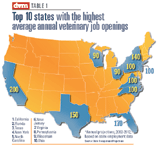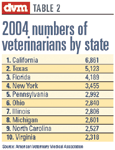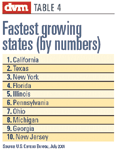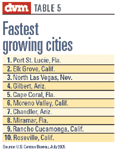Where do I go from here?
National Report — Where are the jobs in veterinary medicine?
NATIONAL REPORT — Where are the jobs in veterinary medicine?
The answer: They're everywhere. It's not a sixth sense. State employment agencies, Occupational Employment Statistics surveys, employment demographers and the Bureau of Labor Statistics studies show veterinary medicine will grow about 25 percent during the next five years, making it the 91st fastest growing profession through 2012, according to Career InfoNet.
Numbers of veterinarians are expected to grow at least 11 percent in 42 states through 2012, with the highest increases in New Jersey, Nevada, Virginia, Kentucky and Wyoming (see Table 3).

Table 1. Top 10 states with the highest average annual veterinary job openings
Currently, California has the most veterinarians with 6,861, followed by Texas (5,123) and Florida (4,189), according to the American Veterinary Medical Association (see Table 2). These three states might be the best places to be for employment opportunities, too, with estimates of at least 150 job openings each year between now and 2012 (see Table 1).
Employment of veterinarians is expected to rise 10 to 17 percent for all occupations during the 2004-2014 projection period, according to the U.S. Department of Labor. "Despite this average growth, very good job opportunities are expected because the 28 schools of veterinary medicine, even at full capacity, result in a limited number of graduates each year," reports the Bureau of Labor Statistics Occupational Outlook Handbook.

Table 2. 2004 numbers of veterinarians by state
"As pets are increasingly viewed as a member of the family, pet owners will be more willing to spend on advanced veterinary medical care, creating further demand for veterinarians," the book adds.
Inside, outside the beltway
Although roughly 90 percent of graduating veterinarians enter private practice, Washington, Atlanta and cities that house state public health agencies promise to welcome new employees as the job outlook for veterinarians remains robust in emerging public health and food production sectors, according to Dr. Andrew Maccabe, associate executive director of the Association of American Veterinary Medical Colleges.
The United States Department of Agriculture (USDA) reports an expected 13,000 annual openings for new graduates, while only 12,700 possible qualified individuals enter the job market each year.

Table 3. Percentage increase in available veterinary jobs, 2002-2012
"The work force that is in public health is starting to retire at pretty high rates, so we need to ensure students who are in veterinary school and younger are turned on to other things that veterinarians do (besides private practice)," says Nina Marano, DVM, MPH, Dipl. ACVPM, associate director of veterinary public health at the Centers for Disease Control and Prevention National Center for Infectious Disease. "The shortages that are projected over the coming years are not only to fill current spots, but because of the growth in the need for public health positions, too."
While avian flu, SARS, bovine spongiform encephalopathy and West Nile virus continue to make worldwide headlines, veterinary positions in infectious disease and food production will continue to grow, experts say.
"Scientists, engineers, veterinarians and technical specialists likely will account for about 25 percent of all projected jobs for college graduates in food, agriculture and natural resources system," according to a USDA career outlook report.

Table 4. Fastest growing states (by numbers)
The most opportunities exist in precision agriculture, functional genomics, bioinformatics, forest science, plant and animal breeding, biomaterials engineering, food-quality assurance, nanotechnology, animal health and well-being, nutraceuticals development and environmental science, the report says.
"Colleges offering programs in veterinary medicine and in agriculture and natural resources will graduate between 55 percent to 60 percent of the qualified applicants for these positions," USDA adds.
USDA employs roughly 1,000 of the 2,400 veterinarians currently working in public health positions. Its Food Safety Inspection Service division expects to have about 500 positions open during the next five years.

Table 5. Fastest growing cities
"Veterinarians are in a unique position to fill these roles because they are well suited to address problems in health management and preparedness," CDC's Marano says. "The education that we get in veterinary school is based on population, and the recommendations that they make are going to preserve the health of the rest of the populations."
Interest might be catching up with demand.
About 300 students from 28 North American veterinary colleges participated in a CDC career day in January to learn more about opportunities in public health.
"We were overwhelmed by the response," Marano says. "It is a good time to consider this because with the unique training that veterinarians have, they are well suited to face problems with health preparedness, and they can rise to the very top of many of these organizations."